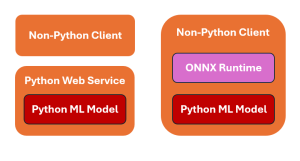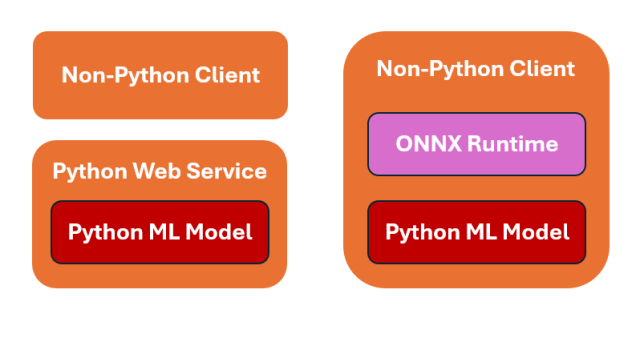
When working with Python-based machine learning models, a common question that pops up is how do we invoke models written in Python from apps written in other languages?
The picture below represents two strategies for invoking Python machine learning models from client applications written using other programming languages such as Java, C++, C#, etc.
The following is explanation for the above:
- Web service based invocation: The diagram on the left represents wrapping a Python ML model within a web service and exposing its functionality through a REST API. You can wrap Python ML models using frameworks such as Flask. This is a powerful way to make the model accessible to a wide range of client applications including Java, C++, C# etc. This approach allows any application or service that can send HTTP(s) requests to interact with Python ML model seamlessly. Here is the sample Flask code:
- ONNX Runtime based invocation: The diagram on the right shows another strategy— Exporting a Python model to a platform-agnostic ONNX (Open Neural Network Exchange) format, and then using an ONNX runtime to load the model in other programming languages. Once loaded, the model can be called via the ONNX runtime.
Sample Flask Code for Python Web Service
The following is the sample Python Flask application to work with a pre-trained ML model saved as model.pkl (pickle file). Non-python client can invoke this webservice appropriately. The model is loaded once when the server starts, ensuring efficient use of resources. The /predict endpoint accepts POST requests containing JSON data. It extracts the necessary features, makes a prediction using the loaded model, and returns the result in JSON format.
from flask import Flask, request, jsonify
import pickle
app = Flask(__name__)
# Load the pre-trained model
with open('model.pkl', 'rb') as f:
model = pickle.load(f)
@app.route('/predict', methods=['POST'])
def predict():
data = request.get_json(force=True)
# Assuming the input data is a dictionary of features
features = [data['feature1'], data['feature2'], data['feature3']]
prediction = model.predict([features])
return jsonify({'prediction': prediction.tolist()})
if __name__ == '__main__':
app.run(debug=True)
The above code can be tested using curl or Postman. Here is the sample curl code:
curl -X POST http://localhost:5000/predict \
-H "Content-Type: application/json" \
-d '{"feature1": 5.1, "feature2": 3.5, "feature3": 1.4}'
Sample Code for Working with ONNX Runtime
The process of exporting a Python model to ONNX varies depending on the framework used to build the model. In the code sample below, we will be exporting model from Scikit-learn.
First and foremost, we need to install ONNX runtime. Here is the code.
pip install scikit-learn skl2onnx onnxruntime
Let’s say we have trained a logistic regression model and we created a pickle file namely, logistic_model.pkl. In the code below, The trained Scikit-learn model is loaded using joblib. The convert_sklearn method is used to convert the Scikit-learn model to ONNX format.
# export_sklearn_to_onnx.py
import joblib
from sklearn_model import model
from skl2onnx import convert_sklearn
from skl2onnx.common.data_types import FloatTensorType
# Load the trained Scikit-learn model
model = joblib.load("logistic_model.pkl")
# Define the initial type
initial_type = [('float_input', FloatTensorType([None, 4]))] # Iris dataset has 4 features
# Convert the model to ONNX
onnx_model = convert_sklearn(model, initial_types=initial_type)
# Save the ONNX model
with open("logistic_model.onnx", "wb") as f:
f.write(onnx_model.SerializeToString())
print("Scikit-learn model has been converted to ONNX format and saved as 'logistic_model.onnx'")
The converted model is serialized and saved as an onnx file. Once the model is exported to ONNX format, we can use ONNX Runtime to load and perform inference. The following steps are performed for inference:
- Loading and Validating the Model: Ensures that the ONNX model is correctly formatted.
- Creating a Session: Initializes an ONNX Runtime session for executing the model.
- Preparing Input Data: Input must match the model’s expected shape and data type.
- Running Inference: Executes the model and retrieves the output.
- Coefficient of Variation in Regression Modelling: Example - November 9, 2025
- Chunking Strategies for RAG with Examples - November 2, 2025
- RAG Pipeline: 6 Steps for Creating Naive RAG App - November 1, 2025

I found it very helpful. However the differences are not too understandable for me